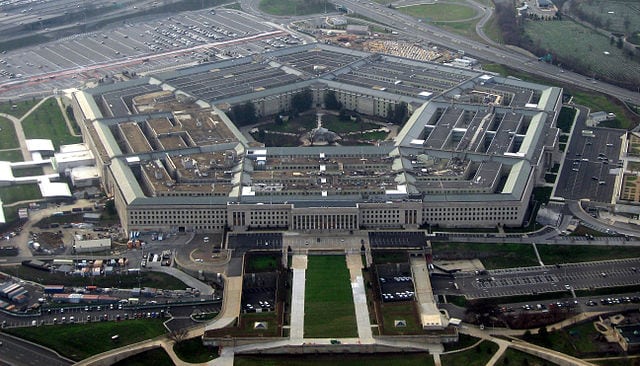Latest News

The Pentagon, headquarters for the Department of Defense. Photo: Wikimedia
We enter the new year with 2020 closely in sight — a period which could mark a profound turning point for U.S. government satellite communication acquisition and implementation. Riding the momentum of a series of events over the past year, federal and industry leaders appear poised to take the next critical steps forward in a strategic partnership; one that would effectively leverage commercially-supplied innovation in the interest of a fully integrated global satellite architecture. For the modern military user, this will result in superior capabilities, resiliency, mobility and security.
There have been some surprises and setbacks, such as the omnibus appropriations bill for Fiscal Year (FY) 2018 funding of $600 million for the purchase of two additional Wideband Global Satcom (WGS) satellites. This funding appeared incongruous with the messages from the White House administration and Pentagon leadership, which continues to stress the necessary reliance on current and future mobility commercial satcom (comsatcom).
Yet, overall prospects for an industry-driven, integrated architecture are clearly gaining traction. The National Defense Authorization Act (NDAA) for FY2018 set the tone with a major reorganization that shifts acquisition of comsatcom Services and oversight to Air Force Space Command (AFSPC). As a result, for the first time, acquisition of comsatcom services will “sit” right alongside milsatcom; a transition that will position the Department of Defense (DOD) to take full advantage of an entirely integrated and holistic approach, as it moves to a unified architecture.
In addition, we await the distribution of the final report from Office of the Undersecretary of Defense for Acquisition, Technology, and Logistics’ (OSD/AT&L) Analysis of Alternatives (AOA) for Wideband Communications Services (WCS) which did attempt to engage with industry in an unprecedented fashion. It remains unclear, however, what set of effectiveness measures were used to evaluate comsatcom and how comsatcom will be assessed in the envisioned integrated architecture. What is clear is that the DOD has acknowledged the presence of some 17,000 legacy satellite terminals in use today that inhibit the department’s ability to leverage technological advancements available with modern satcom.
Industry, on the other hand, continues to extend its capabilities — enhancing the services provided to the DOD — and does not view legacy terminals as an insurmountable challenge. These terminals will undergo a recapitalization process which should take into consideration the deployment of adaptive modems and multi-band features that will enable roaming across heterogeneous networks. For many communication requirements, offering the terminals as part of the Satcom as a Service model ensures the process of continual technology refresh and modernization at an affordable rate — “Terminals as a Service,” if you will.
A decision bias towards “sunk costs” as an argument against upgrading and/or replacing the existing military terminals should not discourage future investment that favors accelerated operational agility, resiliency and flexibility. If we cling to yesterday’s hardware to avoid a short-term and necessary budgetary expense, then we are pressing an “easy button” that stalls forward momentum for a unified and integrated architecture. This architecture is obtainable best through a strong government and commercial partnership so that capable comsatcom solutions are fully considered as part of the necessary recapitalization process.
Toward this goal, we are encouraged by the unprecedented appropriation of $49.5 million in Research, Development, Test and Evaluation (RDT&E) funding to create a new “program of record for commercial satellite communications” within the U.S. Air Force. While the $49.5 million figure may appear relatively modest, it represents a promising launch point for the more strategic acquisition of comsatcom — laying the groundwork for an interoperable, yet heterogenous network. This network will allow the military to support its most fundamental requirements, while paving the path for industry to globally augment those capabilities with multi-mode and multi-band terminals, adaptive modem interfaces, and additional best-of-breed innovations.
To further advance successfully in this direction, DOD leaders must include procurement as well as Operations and Maintenance (O&M) funding within the Future Years Defense Program (FYDP) to intentionally and strategically acquire comsatcom as part of the overall architecture, and not as an afterthought. This kind of strategic planning will lay a foundation of optimal satcom acquisition — the continuation of O&M within the appropriations budget, supporting a program wrapped around commercially-delivered capabilities.
As a result, we will then move closer to the ideal vision of Satcom Enterprise, leveraging the most capable of both comsatcom and milsatcom systems. With ever-proliferating threats that have accelerated resiliency requirements for commercial and legacy, as well as a small or finite amount of purpose-built government-owned wideband, it will enhance anti-jam protection and enable more effective operations within an increasingly contested environment. This represents an evolution in military thinking, away from focusing strictly on government purpose-built assets and toward all wideband assets, including commercial.
With industry investment and expertise satisfying resiliency requirements, our satellite systems are incredibly capable and adaptable, and we can “move fast.” Thus, a protected tactical strategy employing a diversity of modern commercial satcom capabilities provides the government with rapid and affordable best-of-breed options.
That is why it is imperative to act immediately, to incorporate these enhancements into budget planning for FY 2020 and across the Program Objective Memorandum (POM) and the FYDP. Doing so will deliver operational benefits for critical military missions for years to come, meeting global and mobile demands against a highly dynamic operational and threat environment. The time is now, as we head into 2020, to transform this “launch point” into a true turning point. We owe our servicemen and women nothing less.

Rebecca Cowen-Hirsch is the senior vice president of government strategy and policy at Inmarsat Government.
Stay connected and get ahead with the leading source of industry intel!
Subscribe Now